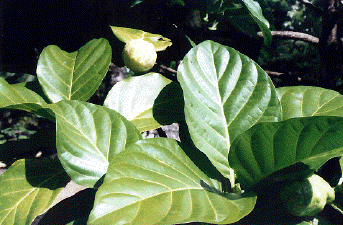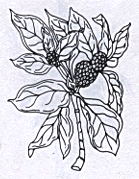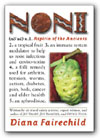Canoe Plants of Ancient Hawai`i Home - Intro - Contents - Bibliography - Links - Credits `Ape - `Awa -`Awapuhi -Hau -Ipu -Kalo -Kamani -Ki -Ko -Kou -Kukui -Mai`a Milo -Niu -Noni -`Ohe -`Ohi`a `Ai -`Olena -Olona -Pia -`Uala -Uhi -`Ulu -Wauke |
Canoe Plants of Ancient Hawai`i Home - Intro - Contents - Bibliography - Links - Credits `Ape - `Awa -`Awapuhi -Hau -Ipu -Kalo -Kamani -Ki -Ko -Kou -Kukui -Mai`a Milo -Niu -Noni -`Ohe -`Ohi`a `Ai -`Olena -Olona -Pia -`Uala -Uhi -`Ulu -Wauke |
 This is a fascinating plant, demanding of our respect. Its prolific beauty, she bears fruit year round...as if to say, "here I am, please use me." However, as you may already be aware, few of us are willing to make its intimate acquaintance. The aroma of its fruit is truly awesome, somewhat like bleu cheese. Some say "disgusting" or "horrid" or "stinks bad" or worse. And, it doesn't taste good either! Yet, it is well-known to be one of the main healers among the traditional Hawai`i medicinal plants. Of all the two-dozen canoe plants that Hawaiians brought on their migrations, noni was the only one that was primarily or exclusively used for medicinal purposes. It is used both as a regular tonic for health maintenance, and it is also said that this plant food is to be used when we are feeling really ill or really old.
This is a fascinating plant, demanding of our respect. Its prolific beauty, she bears fruit year round...as if to say, "here I am, please use me." However, as you may already be aware, few of us are willing to make its intimate acquaintance. The aroma of its fruit is truly awesome, somewhat like bleu cheese. Some say "disgusting" or "horrid" or "stinks bad" or worse. And, it doesn't taste good either! Yet, it is well-known to be one of the main healers among the traditional Hawai`i medicinal plants. Of all the two-dozen canoe plants that Hawaiians brought on their migrations, noni was the only one that was primarily or exclusively used for medicinal purposes. It is used both as a regular tonic for health maintenance, and it is also said that this plant food is to be used when we are feeling really ill or really old. The noni, also known as Indian Mulberry, with the scientific name of Morinda citrifolia, is a small evergreen shrub or tree, usually less than 10 feet high, occasionally rising to 20 feet. The conspicuous large dark green shiny leaves are generally paired, except where forming fruit. Thick and oval in shape, these leaves are deep veined, short-stemmed and 8 inches or longer. The flowers form in globose heads, about an inch long and bearing many small white flowers. The flower heads grow to become mature fruit, 3 to 4 inches in diameter. The fruits resemble those of `ulu, breadfruit, only smaller. The surface is divided into somewhat warty polygonal pitted cells. The noni fruit begins green, turns yellow, and as mentioned, has an unpleasant, insipid, foul or fetid odor, especially as it ripens to whiteness and falls from the tree.
The noni, also known as Indian Mulberry, with the scientific name of Morinda citrifolia, is a small evergreen shrub or tree, usually less than 10 feet high, occasionally rising to 20 feet. The conspicuous large dark green shiny leaves are generally paired, except where forming fruit. Thick and oval in shape, these leaves are deep veined, short-stemmed and 8 inches or longer. The flowers form in globose heads, about an inch long and bearing many small white flowers. The flower heads grow to become mature fruit, 3 to 4 inches in diameter. The fruits resemble those of `ulu, breadfruit, only smaller. The surface is divided into somewhat warty polygonal pitted cells. The noni fruit begins green, turns yellow, and as mentioned, has an unpleasant, insipid, foul or fetid odor, especially as it ripens to whiteness and falls from the tree.
In the early morning, the best time to pick most plants, I have carried a gallon glass jar like the institutional ones for pickles, pule (prayed with) the plant, thanking it for its food. I picked the fruit at its yellow stage, filling the jar and capping it tightly. The jar is placed in a sunny spot, letting it set there for five days to a week or more, until the fruit turns to mush and sun-charged juices drain into the bottom of the jar. It is these juices that can be strained into a cleaner smaller jar, and then refrigerated until used.
Another method taught by Hawai`i's healers is to pick the fruit before ripe, letting it ripen within the home. When soft, place it in a blender with a little fresh water and make into a sauce. Then mash and strain through a sieve. This concoction can be refrigerated in a clean glass jar, and the person who wishes the medicine can take a clean straw and slurp two sucks from the jar, in the morning and in the evening.
As a medicine, the fruit and its juices have been used in the treatment of diabetes, heart troubles and high blood pressure, with different portions prescribed for different illnesses. In these days of ozone depletion, noni is useful in the treatment of skin cancers.
The juices can be diluted with clean water or a fruit juice such as apple, and drunk before meals and at resting periods. Treatment should always be at a relaxed time, not before going to work. It is good to seek the advice of a Hawai`i health practitioner before using any plant medicines. Noni is believed to have been brought here centuries ago by early Polynesian settlers, and is a native of the Pacific islands, Asia and Australia.
The late Uncle Harry Mitchell of Keanae, Maui, suggested using noni with garlic, both being great blood purifiers that enhance the immune system and cleanse harmful bacteria from the body. He also mentioned boiling it for use with diabetes, and using it strained raw for heart problems and high blood pressure, as it is said to increase the flow of blood. Sometimes capsain (cayenne pepper) is added as an ingredient as well.
The young unripe noni fruit can be pounded thoroughly with salt and the mixture placed carefully on deep cuts and on broken bones. Sometimes the juice is squeezed out of this mixture, boiled and applied to the wounds. The ripe fruit can be used as a poultice for facial blemishes, rubbed until the oil disappears, and also to draw out the pus and core from an infected sore or boil, such as with a staph infection. In the old days, this was tied on with a bandage of tapa bark cloth. The dressing of noni could be reapplied more than once for difficult cases.
There are those who eat noni's fruit unripened, either as a food in times of scarcity, or as a tonic when needed. Other people make a tea using the leaves of this plant. The fruit can be used in recipes as a reputed remedy against tuberculosis, arthritis, cancer, rheumatism and the changes of old age. The leaves and bark of the stem can be pounded and strained, resulting in a liquid drunk as a tonic or for urinary disorders, muscle and joint pain. The leaf can also be heated over a fire or with an iron to bring out the oils, and then wrapped as a type of poultice for areas of skin that are inflamed, bruised, burned or otherwise in need of healing. The juice of the fruit is applied to the hair to rid it of head lice, uku, followed whenever possible by a fragrant shampoo of `awapuhi kuahiwi or coconut water.
Other uses for this ancient Polynesian plant: the bark yields a red dye, while a yellow dye can be prepared from the root. Both colors were use to dye the tapa cloth of the chiefs of ancient Hawai`i. Noni is a kinolau of the god Ku.
Noni is a valuable plant to have nearby the home of anyone wishing to utilize the many natural healing properties of this remarkable life sustaining plant. Cultivation is either by seed or cutting.
 NONI: Aspirin of the Ancients
NONI: Aspirin of the AncientsUH Manoa College of Tropical Agriculture and Human Resources (CTAHR) Noni website
| Canoe Plants of Ancient Hawai`i Home Intro - Contents - Bibliography - Links - Credits `Ape -`Awa -`Awapuhi -Hau -Ipu -Kalo -Kamani -Ki -Ko -Kou -Kukui -Mai`a |